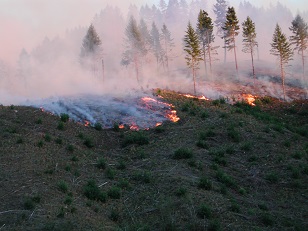Brad Withrow-Robinson, OSU Forestry & Natural Resources Extension for Benton, Linn and Polk Counties.
I talked to my friend Philipp in Portland the other night. We were checking in on family, comparing notes on how each are doing under the Stay Home order. The big beneficiary at their house is the dog, Coffee, who has his four people at home and who seem unusually willing to take him for a walk. Phil was also laughing that his yard had never been so free of weeds.
Weeds had never been one of Philipp’s priorities. Until now.

I have noticed that many rural landowners look at Fire Preparedness much like Phil looks at weeds. In fact, many rural landowners are much more aggressive about clearing their home place of weeds, than they are about clearing their home place of fire hazards.
Left: Three Zones of Defensible Space. Image from: https://bewildfireready.org/fuels-reduction-cost-share-program/
Maybe this is the time to change that. 2020 presents both an opportunity and a need for fire planning and preparedness.
The opportunity: many people are spending more time at home than ever before. Some are looking for things to do at home, others already have lists. If improving your fire preparedness is not on your list, then I would suggest it should be. You and your family can take on and accomplish many helpful actions, with no challenge to social distancing requirements. Other tasks may require outside assistance, and may not be doable this year. But this is an ideal opportunity to assess your situation, develop a plan, start doing what you can yourself, and get set to do the bigger tasks in the future.
The need: may be more urgent than normal as fire teams grapple with the challenges of how to muster and deploy fire crews in a pandemic. Nothing about a fire fighting conforms to social distancing requirements: crews are crowded together in vehicles, on lines, in large fire camps, in terrible air quality.

Additionally, we are looking at another dry year, with below normal rainfall. We already have fire conditions (I just heard about two fires this week), and we should maybe be expecting an early declaration of fire season.
Right: Dupee Valley Fire. Photo: Bent O’Nion, ODF.
We need to think of our wildland fire fighters as we do the other first responders: recognize their commitment and dedication, and show our appreciation by doing all we can to assist them.
Step one of course is following the advice of health experts to prevent the spread of COVID-19. First responders cannot help us if they are sick.
The next step is to try to prevent the need for their service. The request by several state agencies to refrain from outdoor burning if possible this spring is meant both to reduce the risk of fire escapes, and to maintain good air quality as a public health strategy. Remember the vast majority of fires in western Oregon are human caused. Some are related to farm and forest operations, but many others stem from careless back yard burning practices.
Finally, in the case that they are needed, we can all make fire fighters’ service more effective and less hazardous by being prepared. This includes defensible space around our homes and an evacuation plan for our families, which we have addressed before. Which takes us back to the 2020 opportunity to become more prepared for fire.
For help on how to improve your preparedness, please visit the Before Wildfire Strikes page on the OSU Forestry & Natural Resources Extension Fire Program website. There you will find many useful publications and videos to help you make your home and property safe.
After all, you have nowhere else to go right now.
